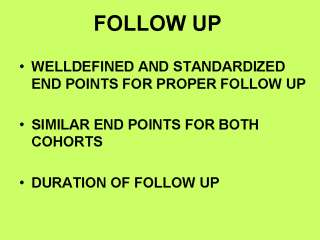| front |1 |2 |3 |4 |5 |6 |7 |8 |9 |10 |11 |12 |13 |14 |15 |16 |17 |18 |19 |20 |21 |22 |23 |24 |25 |26 |27 |28 |29 |30 |31 |32 |33 |34 |35 |36 |37 |38 |39 |40 |41 |42 |43 |44 |review |
 |
Cohort study is an
incidence study. Hence the exposed and unexposed groups have to be followed
for the occurrence of new cases or expected outcomes or end-points.
These end-points have to be standardized even before the follow-up is initiated. Any difference in endpoints will result in loss of validity The end points or outcomes expected are to be defined clearly for observation during follow up. These should be the same for both the cohorts otherwise analysis and inference will be false. Both the cohorts have to be followed up in similar fashion without any difference. The duration for follow up depends upon both the induction (initiation or onset of disease) and incubation periods (period when clinically appears) of the disease in question. It may be longer as in cancers, usually years. |